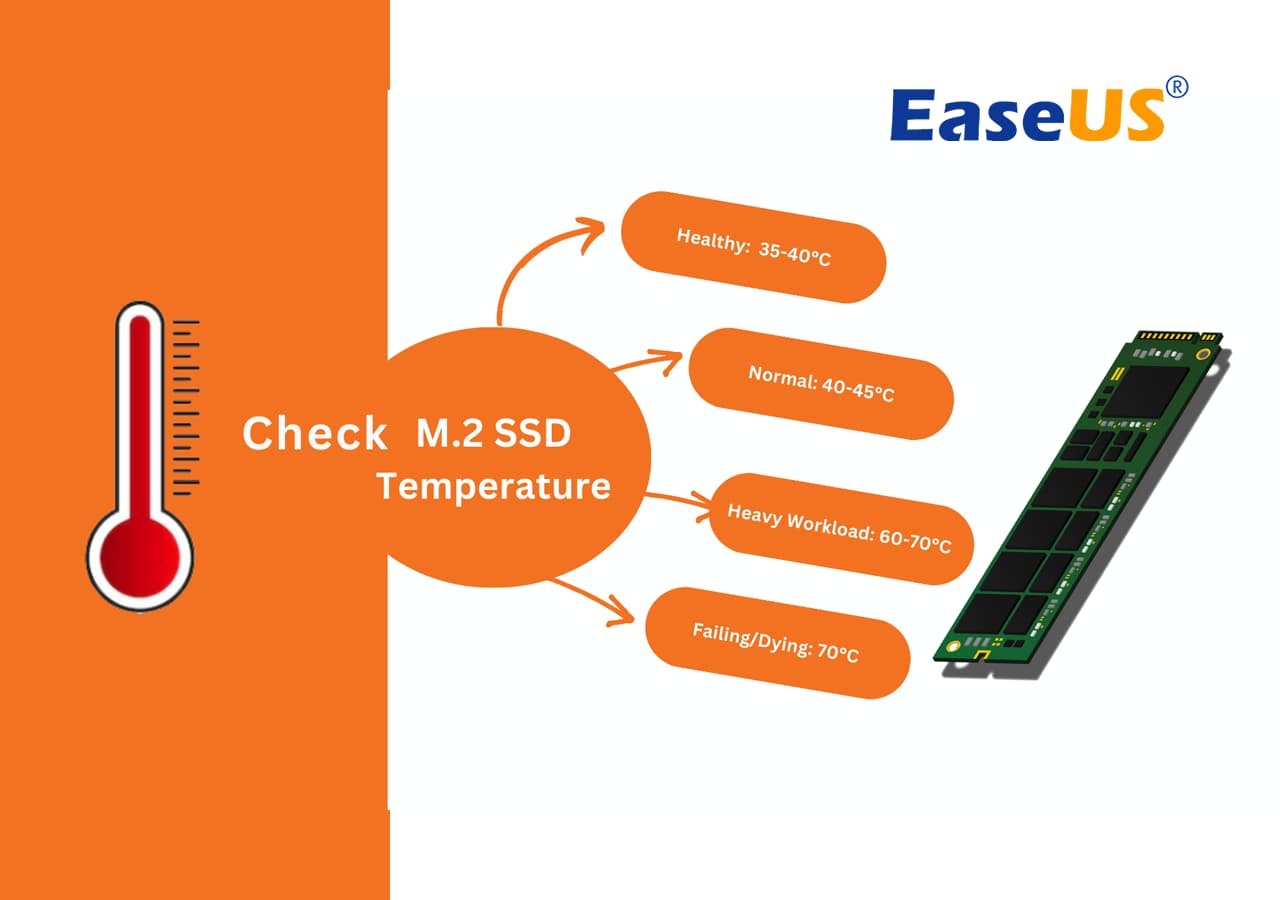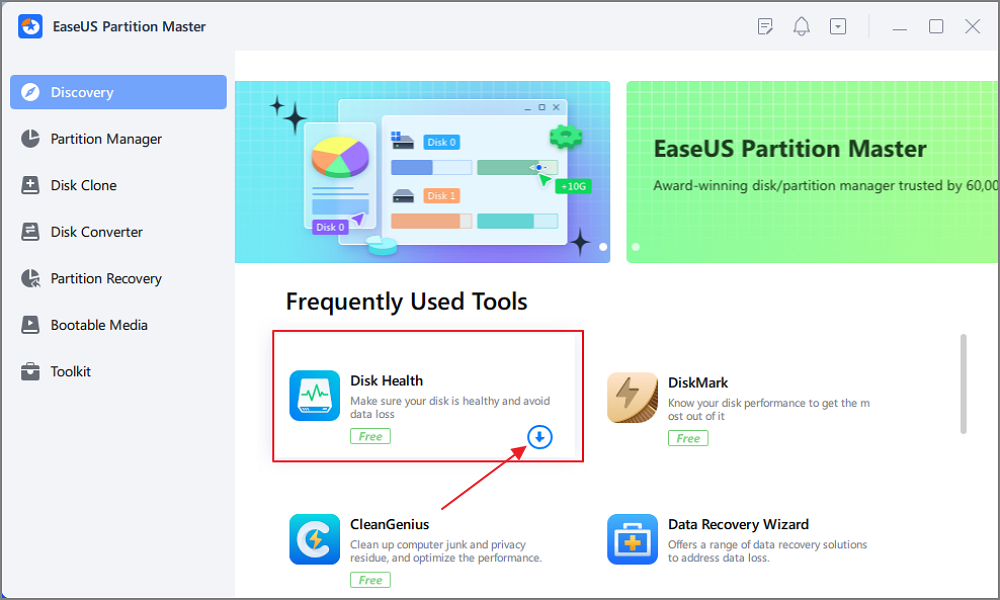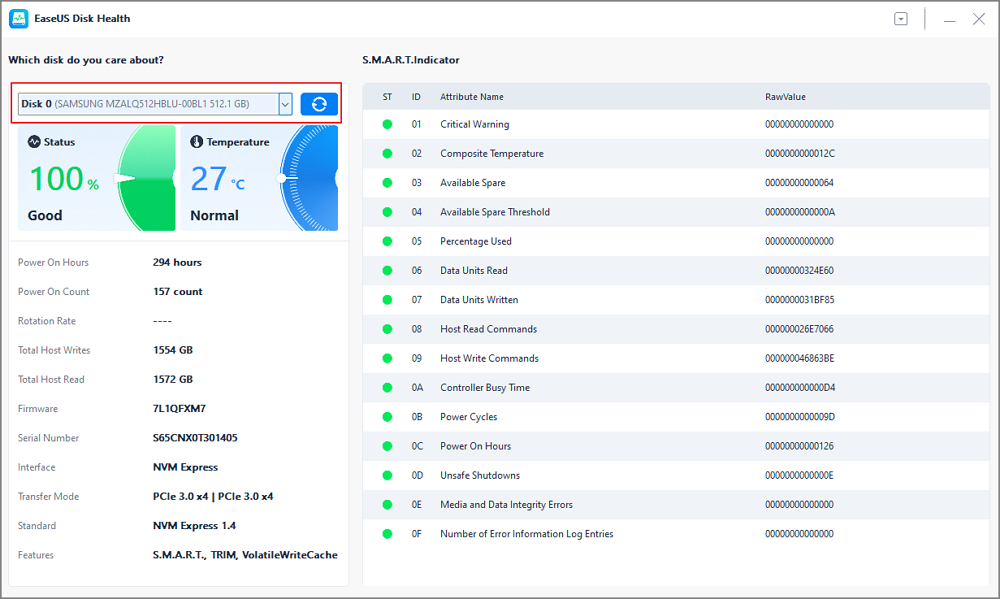Page Table of Contents
About the Author
Hot Topics
Updated on Nov 04, 2024
The exceptional speed and compact physical size of M.2 solid-state drives (SSDs) have contributed to their growing popularity. Consequently, monitoring their temperature becomes a vital aspect to consider. Monitoring the temperature of your M.2 SSD is essential because excessive heat can impact its performance and longevity. Experts use several practical methods to check M.2 SSD temperature.
These methods include the motherboard's BIOS or UEFI settings, the SSD manufacturer's software, and using an Infrared thermometer. Nevertheless, these methods can be confusing and overwhelming for most new users. This guide will explore the easiest method to check M.2 SSD temperature. It will provide a step-by-step guide to ensure that you can accurately determine your M.2 SSD's temperature.

How to Check M.2 SSD Temperature [Step-by-Step Guide]
Checking the temperature of your M.2 SSD is a simple yet crucial task to ensure its optimal performance and prevent overheating. In this step-by-step guide, we will walk you through the easy and detailed process to check M.2 SSD temperature:
#1. Preparations
Before you begin checking the temperature of your M.2 SSD, you need to be fully prepared. We have outlined all the required preparations into a respective table as shown below:
| M.2 SSD | Get your M.2 SSD ready that needs to be assessed. |
| M.2 SSD Temperature Check Tool | Use EaseUS Partition Master as the M.2 SSD Temperature Check tool. |
| Windows Computer | Use it for checking the temperature of M.2 SSD. |
| M.2 Connection Cable | Used for connecting the M.2 SSD to the computer. |
#2. Download M.2 SSD Temperature Check Software/Tool
After you have made the initial preparations, the next step is to download the M.2 SSD temperature checker tool - EaseUS Partition Master. It is available for free to download and provides an exceptional Disk Health feature.
Using this feature, you will be able to easily determine the temperature of your M.2 SSD. You can find out your M.2 SSD temperature, free space, health, performance, and other information using Disk Health.
This tool is extremely easy to use, and it provides detailed health reports in a way that is understandable even to novice users. The process of checking your M.2 SSD's temperature is also extremely easy and requires just one click.
#3. Step-by-Step Guide to Checking M.2 SSD Temperature
By following these steps, you can easily monitor the temperature and take necessary actions if needed:
Step 1. Launch EaseUS Partition Master and click the blue arrow to activate the "Disk Health" feature under the "Discovery" section.

Step 2. Select the target disk and click the "Refresh" button. Then, you can see the health condition of your disk.

From the disk health monitoring result window, you can clearing see the real time temperature of your M.2 SSD in your PC.
Interpret the Temperature Test Result, Confirm If M.2 SSD Is Overheated
To better understand and interpret the temperature test result of your M.2 SSD, it is essential you know the normal temperature of an M.2 SSD.
- ✔️The usual temperature range at which an M.2 SSD operates falls within approximately 30ºC to 65ºC (or 86ºF to 149ºF).
That is generally considered acceptable, and that's where your M.2 SSD's temperature should be in working condition. Concern is usually unnecessary as long as the SSD stays within this range.
- ✔️Nevertheless, surpassing a temperature of 70ºC may result in failure and ultimately terminate the lifespan of the SSD.
- ✔️However, as long as the temperature of your M.2 SSD is over 60 degrees, it is a cause for concern. When the temperature of an SSD goes beyond 60 degrees, its performance tends to deteriorate rapidly.
This phenomenon is known as thermal throttling. To avoid this, keeping the SSD temperature below this threshold is recommended.
Furthermore, it is essential to consider the temperature during idle periods. Should the temperature of the SSD exceed 50 degrees during system idleness, it is advisable to investigate the underlying cause of this concern.
- 📌Ideally, when your computer is idle, the system temperature should not surpass 40 to 50 degrees Celsius.
You may refer to this page: SSD Temperature Range for more details.
Factors Affecting M.2 SSD Temperature with Tips to Cool Down Overheating M.2 SSD
To ensure optimal performance and prevent potential damage, you need to be aware of the factors that can affect the temperature of your M.2 SSD. Here, we'll discuss these factors in detail, learn when to check M.2 SSD temperature, and provide you with practical tips to cool down an overheating M.2 SSD:
Factors That Affect M.2 SSD Temperature 🌡️
Understanding the factors that can affect the temperature of your M.2 SSD is crucial. Various factors can influence the temperature of your SSD, and being aware of them helps you make informed decisions regarding cooling and maintenance. In this section, we'll explore the key factors that can impact the temperature of your M.2 SSD:
Drive Utilization 💽
How much you are using the SSD can be a big factor in impacting its temperature. When the SSD is engaged in continuous read/write operations or running intensive applications, it requires more power and generates more heat. This increased heat production can elevate the temperature of the SSD.
Drive Capacity 🛠
An M.2 SSD's capacity can affect its temperature, but the difference is generally not significant. Larger capacity SSDs tend to have more NAND flash memory chips, which can be active simultaneously during data operations. This increased activity can generate more heat.
Ambient Temperature 🔥
The temperature of the environment in which the SSD operates can impact its overall temperature. When the ambient temperature rises, the effective heat dissipation of the SSD becomes more difficult. It is especially critical in scenarios where the computer operates in a poorly ventilated or hot environment.
Overclocking 🚀
Overclocking involves pushing a component, such as the SSD controller, beyond the clock speed or voltage limits. When overclocking an SSD, the increased voltage or clock speed can lead to higher power consumption and generate more heat. It can result in elevated SSD temperatures.
When Should You Check Their M.2 SSD Temperature
Regularly monitoring the temperature of your M.2 SSD is considered a beneficial practice to ensure it remains within safe operating temperature ranges. By checking the temperature, you can proactively detect and address potential issues like overheating. Here are some situations when you should consider checking the M.2 SSD temperature:
Intensive or Prolonged Usage
During resource-intensive tasks like large file transfers, video editing, or gaming, your M.2 SSD experiences a heavier workload, resulting in increased heat generation compared to regular usage. This increased heat production can potentially affect the temperature of the SSD. Checking the temperature periodically during or after such intensive usage can help you ensure that the SSD is operating within safe temperature limits.
System Upgrades
Monitoring the temperature of your M.2 SSD is recommended when you've recently installed a new one or upgraded to a different model. Different SSDs can have varying thermal characteristics, and changes in storage capacity or performance may affect the temperature as well. By checking the temperature after such upgrades or modifications, you can ensure that the new SSD is functioning properly.
Performance Issues
If you observe a sudden drop in performance or experience system sluggishness during disk-intensive operations, it may suggest the occurrence of thermal throttling. Thermal throttling is a mechanism employed by SSDs to protect themselves from overheating. When the SSD temperature exceeds a certain threshold, it may automatically reduce its performance to dissipate heat and prevent damage.
Regular maintenance
Including temperature monitoring as part of your routine system maintenance can help you proactively identify any temperature-related issues with your M.2 SSD. You can schedule regular checks using monitoring software or manually check the temperature occasionally. Regular monitoring allows you to establish temperature patterns under normal usage conditions, helping you detect any unusual temperature spikes that may indicate a problem.
Tips To Optimize M.2 SSD Temperature
Keeping your M.2 SSD in optimal condition is beneficial for you in the longer run. Implementing these tips can help maintain optimal operating conditions and potentially extend the lifespan of your SSD:
- Ensure Proper Airflow: Make sure your computer case has adequate airflow to prevent heat buildup. Ensure that there are proper intake and exhaust fans and that the M.2 SSD has enough clearance for airflow.
- Use Thermal Pads or Heat Sinks: Consider using thermal pads or heat sinks specifically designed for M.2 SSDs. By expanding the available surface area for heat transfer, these accessories can effectively enhance heat dissipation.
- Avoid Overclocking: Overclocking your M.2 SSD can increase its temperature. To mitigate heat-related concerns, avoiding overclocking the drive is recommended, as it can lead to higher-than-normal operating temperatures.
- Monitor Temperatures: Use software utilities or monitoring tools to keep an eye on the temperature of your M.2 SSD. It will help you identify any potential overheating problems and take necessary actions promptly.
- Avoid Extreme Ambient Temperatures: Avoid exposing your computer to extreme ambient temperatures. Excessively high or low temperatures in the environment can impact the operating temperature of your M.2 SSD.
Conclusion
In conclusion, when it comes to monitoring the temperature of your M.2 SSD, EaseUS Partition Master stands out as the best choice. Its amazing Disk Health feature and user-friendly interface offer a comprehensive solution for keeping an eye on your SSD's temperature and ensuring its optimal performance. The Disk Health feature of EaseUS Partition Master allows you to check M.2 SSD temperature effortlessly.
This valuable information empowers you to proactively address any potential issues arising from overheating, such as decreased performance or data loss. By regularly monitoring the temperature, you can take timely actions to prevent damage and extend the lifespan of your SSD. Moreover, it includes many other features like 4K Alignment, check file system, surface test, and disk speed check. All these features enable you to optimize your M.2 SSD to near-perfect condition.
FAQs about Checking M.2 SSD Temperature
Here, we'll address common queries and shed light on how to check M.2 SSD temperature in Windows 11/10. Read on to find answers to your burning questions.
1. What is the best SSD temperature monitor?
Regarding the best SSD temperature monitor, EaseUS Partition Master stands out as a reliable and effective choice. Its Disk Health feature allows you to monitor the temperature of your M.2 SSD with ease and accuracy. The software provides real-time temperature readings, enabling you to monitor your SSD's thermal performance closely.
2. When should I monitor or test my M.2 SSD temperature?
Monitoring or testing your M.2 SSD temperature is crucial for ensuring its optimal performance and longevity. If you're engaging in resource-intensive tasks such as gaming, video editing, or running demanding software, monitoring your SSD temperature is advisable. You should also monitor your M.2 SSD temperature when facing frequent system crashes or slowdowns and as part of regular preventative maintenance.
3. How do I test my M.2 SSD on Mac?
Here is how you can test your M.2 SSD on Mac:
Step 1: Click the Apple icon from the top left corner and hover the mouse pointer on "About this Mac". Now press the "Option" key from the keyboard, and the "About this Mac" will change to "System Information", which you need to click.
Step 2: In the "System Information", navigate to the "Storage" tab and select your M.2 SSD. You will be able to see all the information on your M.2 SSD, including S.M.A.R.T status.
How Can We Help You
About the Author
Sherly joined EaseUS in 2022 and she has always loved writing articles and enjoys the fun they bring. She receives professional training here, focusing on product performance and other relative knowledge. She has written over 200 articles to help people overcome computing issues.
Written by Tracy King
Tracy became a member of the EaseUS content team in 2013. Being a technical writer for over 10 years, she is enthusiastic about sharing tips to assist readers in resolving complex issues in disk management, file transfer, PC & Mac performance optimization, etc., like an expert.
Product Reviews
-
I love that the changes you make with EaseUS Partition Master Free aren't immediately applied to the disks. It makes it way easier to play out what will happen after you've made all the changes. I also think the overall look and feel of EaseUS Partition Master Free makes whatever you're doing with your computer's partitions easy.
Read More -
Partition Master Free can Resize, Move, Merge, Migrate, and Copy disks or partitions; convert to local, change label, defragment, check and explore partition; and much more. A premium upgrade adds free tech support and the ability to resize dynamic volumes.
Read More -
It won't hot image your drives or align them, but since it's coupled with a partition manager, it allows you do perform many tasks at once, instead of just cloning drives. You can move partitions around, resize them, defragment, and more, along with the other tools you'd expect from a cloning tool.
Read More
Related Articles
-
SanDisk Format Solution: Format SanDisk to The Best Performance on Your Own
![author icon]() Tracy King/2024/11/27
Tracy King/2024/11/27 -
Xbox 360 Hard Drive Upgrade: Step-by-Step Guide
![author icon]() Cici/2024/09/19
Cici/2024/09/19 -
How Do I Force Format SD Card on Windows 11/10? Your Guide Here
![author icon]() Tracy King/2024/11/25
Tracy King/2024/11/25 -
CHKDSK Not Working in Windows 11/10/8/7? Fix It Now!
![author icon]() Tracy King/2024/10/29
Tracy King/2024/10/29
Hot Topics in 2024
EaseUS Partition Master

Manage partitions and optimize disks efficiently








